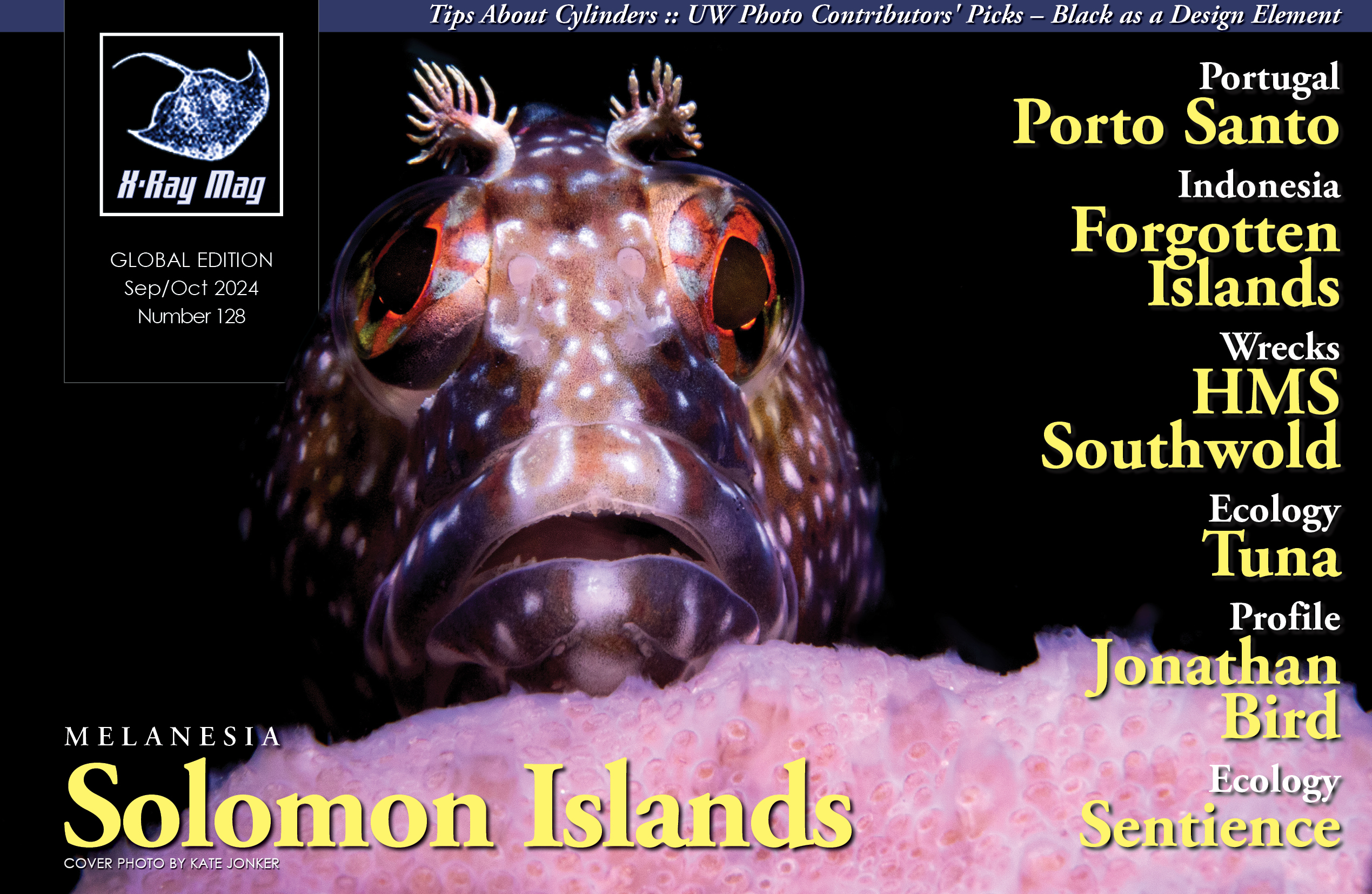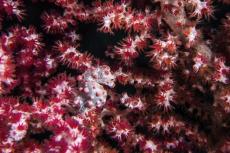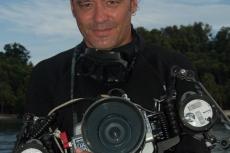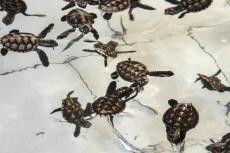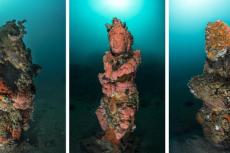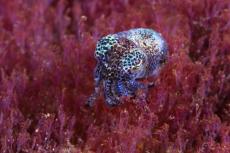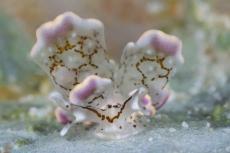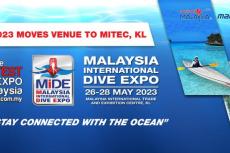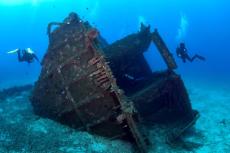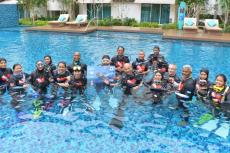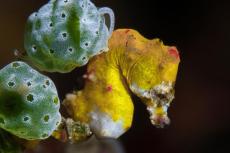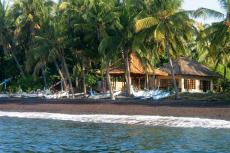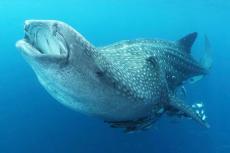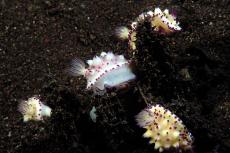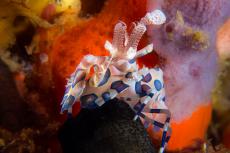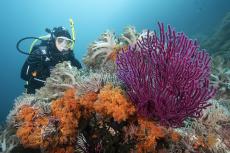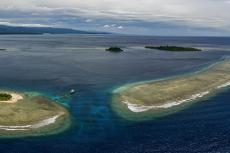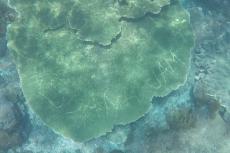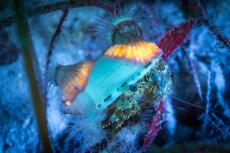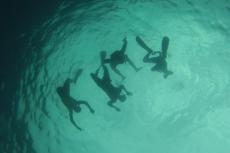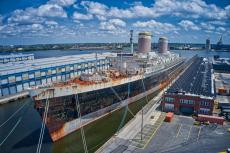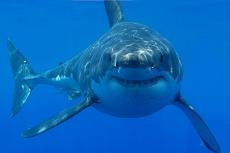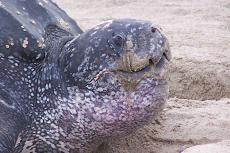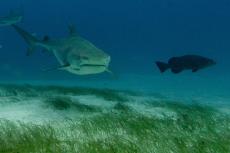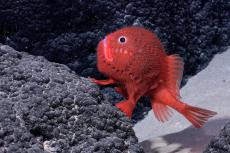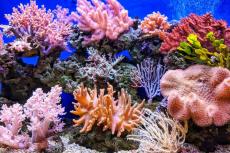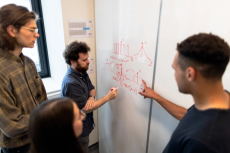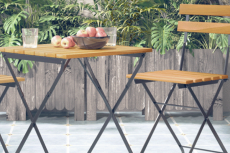Far away from the stress of everyday life and modern civilisation lies a paradise in the middle of the Coral Triangle, where time has stood still. Claudia Weber-Gebert tells of her adventure to Indonesia’s Banda Sea and the Forgotten Islands.
Contributed by
In this part of Indonesia, there are areas completely free of human influence, with no internet or cell phone reception. It is a good opportunity to switch off and enjoy the beautiful nature above and below the water.
The liveaboard trip began in bustling Ambon. But within a few hours, our boat was far enough away from populated areas to feel remote, and the journey to the unforgettable underwater worlds of the Banda Sea began in earnest.
We were in the so-called Coral Triangle, where the Indian and Pacific Oceans meet. The water is warm around the equator, and underwater life literally explodes in this region. Here, you can find the greatest variety of hard corals, soft corals and sponges—not to mention fish and all kinds of marine life. Biodiversity here seems to burst forth like colourful fireworks.
Getting there
Our journey took us from Ambon via Nusa Laut to the Forgotten Islands, including the outer Banda Islands, Banda Neira, and the volcanic cone of Manuk, on towards Yamdena, and finally to the port of Saumlaki, where our journey ended. Aboard the Gaia Love liveaboard, we covered around 1,000km (~620mi) as we crossed the Banda Sea from north to south.
The open sea can be a bit bumpy at times. Luckily, the Gaia Love, which has been recognised by the 2024 Reader’s Choice awards, is a steel vessel that sits very calmly in the water, making it suitable for divers who are prone to seasickness. To cover the long distances across the open sea, our boat sailed at night, and we arrived at a reef near an island in the morning for our first dive.

Reefscapes
The reefs are located where small volcanic islands have risen from the depths of the Banda Sea. If you look at the map, you can see a semicircular ridge with volcanic islands protruding above the water’s surface on either side. We came across reefs that were nearly untouched and still intact. The small, isolated islands in the Banda Sea were sometimes sparsely populated or uninhabited. Most were just small fishing villages with a few huts peeking through the vegetation. Only in the outer Banda Islands and Banda Neira could larger towns be found.
The underwater landscapes were very varied. Sometimes, there were flat, sandy coral gardens, and sometimes, there were steep drop-offs with huge coral fans—an El Dorado for underwater photographers. These sites were particularly good for wide-angle photography of colourful reefs. But, of course, there were also lots of small creatures sitting on and between many of these colourful corals and sponges, ideal for macro photography. With their trained eyes, the dive guides found even the tiniest of critters.
All the landscapes during the dives were dotted with giant barrel sponges populating the reefs. Schools of fish, moving like ribbons through the clear water, grouped in and around these barrel sponges. Visibility varied. In some places, there was a little more plankton in the water, brought in by the ocean currents. But most of the time, you could still see other divers, even from 30m (~98ft) away. And at some dive sites, if you looked down, the entire bottom was often covered with corals and sponges of all kinds. There were hardly any gaps in the reef, with huge corals and an almost indescribable variety of sea life.
Nusa Laut
At the start of our trip, the dive sites around Nusa Laut, still part of the Moluccas, had the most visible traces of human civilisation and the destruction that came with it. On the rocks at one of the dive sites, we saw a huge, discarded net, overgrown with reef life and as still as a memorial. Fishing lines could be seen here and there, but they posed little threat. But the further we travelled away from civilisation, the more beautiful the dives became, with intact and colourful coral reefs and lots of fish.

Banda Islands
Next, the outer Banda Islands came into view, with their green volcanic craters and lots of seabirds. The birds sat in the trees like big fruits. The frigate birds were particularly noticeable, harassing seabirds returning from a hunt until they vomited up their prey and dropped it in desperation—a clever tactic by these pirates of the skies.
Although we dived on many beautiful and breathtaking reefs on our trip, one site in particular impressed us: the Lava Flow dive site at Gunung Api. This island volcano erupted in 1988, and a wide stream of lava flowed into the sea and over the existing reef. A broad strip of this reef was completely covered in lava and destroyed—a tragedy, some might think, but nature knows better.
A short time later, new corals formed on the lava and grew at a rate that amazed even scientists. You can see the marks the researchers made on the corals to measure their growth. It is very interesting because today, the staghorn corals are so densely packed in this exact spot that it is impossible to put a finger on the ground anywhere. Nobody expected this after the destruction. Above the water, you can see how the ribbon of lava flowed from the top of the crater down to the water. But below the water’s surface, nothing of it is visible today. It is a very special and wonderful dive site with the densest corals I have ever seen.
On the way back from the dive site, we were surprised by a large pod of melon-headed whales (also known as electra dolphins)—an incredible sight. Around 300 to 400 individuals circled the liveaboard, and some happily played in the bow wave of the skiffs. It was as if these beautiful cetaceans had come especially to greet us. They were resting in the calm waters around the islands before returning to hunt in the open sea and at great depths. These animals can grow up to three metres (~9ft) long. Unfortunately, little is known about this species of cetaceans.
During our dives, we also saw the occasional hammerhead shark, especially on the steep walls. The area was known for this, but it was not the right season for hammerheads. So, we only saw the occasional hammerhead from a distance. In September, hundreds of hammerhead sharks gather here in a truly amazing sight. But okay, you cannot have everything in a single trip!

Banda Neira
On Banda Neira, we took a shore excursion to the plantations. Nutmeg and cinnamon are still grown and exported here. These plantations once belonged to the Dutch East India Company, and in the small museum in town, our guide told us the terrible history of the enslavement of the local population as the trade in valuable spices such as nutmeg and cinnamon developed. Today, the plantations earn a small additional income from visitors.
Homemade bread with nutmeg jam was served with nutmeg cake and tea. In Europe, only the dried seeds of the nutmeg fruit are known as a spice. However, the yellow fruit around the seed is sweet and is used in many local dishes. The red aril, or seed covering, around the core, which is visible when the ripe fruit bursts open, is particularly valuable. This is also dried and sold as mace, a spice with a similar but more delicate flavour to nutmeg.
After returning from the shore excursion and a little refreshment on board, a special night dive was scheduled to see the colourful mandarinfish that can be seen in the town harbour in the evenings. Just in time for dusk, they emerge from their hiding places in large numbers, while above the surface, local children jump from the harbour wall into the water, almost on top of the divers’ heads. While mandarinfish are often rather shy elsewhere, they were not shy here at Banda Neira.

The plastic problem
The beauty of the reefs in the region can make it easy to forget a significant problem in the area. It was only when we visited the islands on land that we realised that single-use plastic had no place in this society. Vegetables were grown, and fishing was commonplace among the locals. Almost everyone had a few chickens in the garden. But the islands were also supplied with food and goods by boat once a week.
Like in our supermarkets, modern goods and electronics come in plastic packaging. However, there was no way to dispose of this plastic on the islands—let alone recycle it. There was no garbage collection and no yellow bags. So, where did the plastic waste go? We saw it piled up on street corners, behind walls and at the edge of the forest. Here, it was either burned or simply left lying around, eventually to be overgrown with plants. And the piles got bigger every day.
Fortunately, the reefs are currently spared from this plastic waste. The dive sites were beautiful, with lots of corals of all kinds and, of course, beautiful barrel sponges of all sizes. And there was something else in abundance—snakes!

Water snakes
Water snakes dive to search for prey between the corals. These highly venemous animals are peaceful as long as you leave them alone. Do not harass them, especially as they ascend to the surface for air. If you remain still, you may also be able to see them up close.
As a diver’s view to the sides is restricted by a dive mask, there can often be moments of surprise when a snake suddenly crosses your line of vision, very close. We also cannot see what is happening behind us. It is, therefore, advisable to look around calmly from time to time and give the snakes plenty of space.

On to Manuk
We sailed through the night to reach another volcanic island 100km (~62mi) away in the middle of open water, with no land in sight. This was Manuk, or Snake Island. The top of its volcano juts out of the water, and clouds of sulphurous steam still rise—evidence that volcanic activity is still omnipresent. The lush green of the island disguises this activity. However, the sulphurous smell that sometimes hangs in the air does not. Underwater, you can also see yellow areas with sulphur deposits in the black sand.
Once again, we came across a lot of water snakes. Their venom is stronger than that of the king cobra. Our dive guides had a healthy respect for them. They said dive suits should fit tightly all over the body so that a snake does not accidentally get caught somewhere in the suit and bite you in a panic. That would be fatal as we were far from any hospital. There was no cell phone reception, not even via satellite. We were far from civilisation, so calling for help was not an option.
But we kept calm and enjoyed our dives on the beautiful reefs around Manuk, which were intact, healthy and simply beautiful to look at. Fishing boats rarely came here, so the amount of marine life and biodiversity was very high. The volcanic island was an oasis in the middle of the open sea.
It was also clear why there were so many snakes. Water snakes need land. They do not live exclusively in the water. They usually spend the day in caves and crevices on land, curled up with many of their own kind. At night, they go out to hunt. And they lay their eggs on land.
Nevertheless, many snakes also go out in the water during the day to search for prey. But this is only because there are fewer birds of prey on the remote islands in the Banda Sea, which are the snakes’ only threat. However, you can sometimes see birds of prey diving to catch a water snake and carry it away.
Over the course of evolution, the bodies of water snakes have become increasingly flattened, and a real fin has developed at the end of the tail, making it easier to swim in the water. Interestingly, water snakes often work with large mackerels as they hunt together. The snakes drive the prey fish out of their burrows, and their reward is a few pieces of fish left over by the mackerels, which cannot hunt in the narrow cervices themselves.

Yamdena
Our journey continued south to the coast of Yamdena. Strips of coral reefs have formed on the edges of shallow lagoons with mangroves. The water was flooded with sunlight that shone through large sea fans and hard corals. We still had two more days of diving ahead of us, and we had not seen another dive boat the whole time. Like everywhere else on our trip, we had the dive sites all to ourselves. With the divers divided into four small groups, each with a dive guide, the dives were relaxed, and there was a lot to see. Individual dives without a group were the hallmark of this trip, which could not have been better.
After 12 days of diving, with three to four dives a day, we entered the port of Saumlaki with our camera memory cards full to the brim of wonderful impressions of the Banda Sea—both above and below the water. The coral reefs here were unique and in no way inferior to those in well-known places like Raja Ampat.
Overwhelmed by the beauty of the Banda Sea and the peace and isolation of the Forgotten Islands, it was hard to say goodbye. The crew and our tour managers had grown on us, and we had made new friends and acquaintances with the other guests. Indonesia has so many wonderful places to visit, and we look forward to our next trip on the Gaia Love. ■
For more information, visit: divegaia.com
Watch Dive Gaia videos:
youtube.com/watch?v=gK0WnO_517o
youtube.com/watch?v=qKWDvNeiFrQ&t=64s
youtube.com/watch?v=K2jgTpEfEw4
Reference: Wikipedia.org



